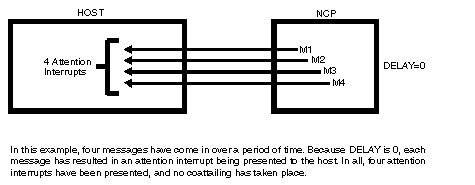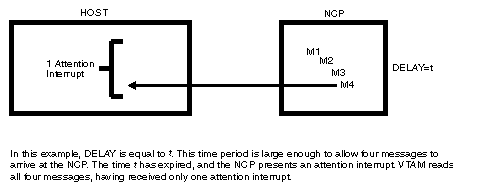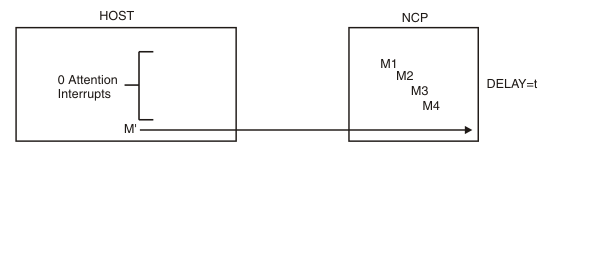 z/OS Communications Server: SNA Network Implementation Guide
z/OS Communications Server: SNA Network Implementation Guide
 z/OS Communications Server: SNA Network Implementation Guide
z/OS Communications Server: SNA Network Implementation Guide
|
Previous topic |
Next topic |
Contents |
Contact z/OS |
Library |
PDF
Guidelines for setting DELAY z/OS Communications Server: SNA Network Implementation Guide SC27-3672-01 |
|
|
To specify the amount of time that elapses before VTAM® or NCP sends buffered data, use the DELAY operand on NCP and VTAM definition statements. The DELAY operand on the NCP BUILD definition statement controls how long the NCP buffers data; it is the elapsed time between the receipt of the first inbound message and the presentation of an attention interrupt to the host. This capability can affect your strategy for increasing coattailing use of the channel. The DELAY operand that controls how long VTAM buffers data can be specified on the following
statements:
The following three examples illustrate the use of the DELAY operand.
Figure 1. Effect of DELAY time on coattailing - example 1
 Figure 2. Effect of DELAY time on coattailing -
example 2
 Figure 3. Effect of DELAY time on coattailing -
example 3
 For NCP, the DELAY operand allows time for more than one message to arrive in the NCP before an attention is presented to the host. The following events cause PIUs on the queue to be sent before
the DELAY time elapses:
The default value for the DELAY operand is 0 (for example, no coattailing).
Take the default under the following conditions:
To analyze inbound coattailing for channel-attached SNA communication or cluster controllers, compare the number of times that NCP signals VTAM that it has data to send (ATTN tuning statistic) to the number of times that VTAM issues a channel READ program to read data (CHRD or RCH tuning statistic). A less accurate method is to divide the number of inbound PIUs transferred by NCP (IPIU tuning statistic) by the number of read channel programs issued by VTAM (CHRD or RCH). This calculation gives you the average number of PIUs read from the channel-attached device with each channel program, which is an indicator of coattailing. Note: For a 3274 to clear its buffers after a data transfer operation,
the 3274 signals to VTAM that
it has more data to send even though there is no data. This causes
the RDATN tuning statistic to equal the CHRD or RCH tuning statistic,
and because RDATN is included in the ATTN tuning statistic, the ATTN
value is normally double the CHRD or RCH value.
To analyze outbound coattailing for channel-attached SNA communication or cluster controllers, divide the number of outbound PIUs (OPIU tuning statistic) by the number of WRITE channel programs VTAM issues (CHWR or WCH tuning statistic). This calculation gives you the average number of PIUs transferred by VTAM with each channel write program, which is a rough estimate of the effectiveness of coattailing. Note: The DELAY specification for a 3174 is a customization option.
However, even if you set the DELAY customization option for a 3174
that is performing a token-ring gateway function, the option is ignored.
The DELAY operand in VTAM should
also be set to 0 for a 3174 that is a token-ring gateway channel-attached
cluster controller.
Specifying a nonzero attention DELAY value to activate attention
DELAY does not automatically ensure coattailing. To ensure coattailing,
all of the following must be true:
Begin by setting DELAY equal to or greater than 0.2. A 0.2-second delay has little effect on response time, but if the traffic speed is approximately 15 transactions per second or greater, coattailing occurs. 


|
 Copyright IBM Corporation 1990, 2014 Copyright IBM Corporation 1990, 2014 |